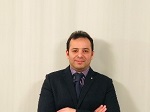Course report
Clinical Practice and Implementation of Image-Guided Stereotactic Body Radiotherapy - PDR Version
10 December 2020 – 9 February 2021, online
Course directors:
Matthias Guckenberger, Radiation oncologist, University Hospital Zurich, Zurich, Switzerland Dirk Verellen, Medical physicist, Iridium Kankernetwerk, University of Antwerp, Antwerp, Belgium
Could you please briefly introduce yourself?
My name is Ayman Ramadan. I graduated from the faculty of medicine at Ain Shams University in Cairo, Egypt, in 1998, and I started my clinical oncology career there in 2000. I finished my master’s degree in 2003 and my doctorate in 2010, both at Ain Shams University. Then I worked in the Gulf region for two years before I decided to gain some Western experience.
I moved to the UK in 2010 and became a fellow of the Royal College of Radiologists in 2017. I started working as a locum consultant in 2015 and I worked in various hospitals, mainly in Essex, southeast England.
Since November 2020 I have been a locum consultant at Maidstone Hospital in Kent.
Why did you choose to attend this course?
I am interested in gaining experience in stereotactic body radiotherapy (SBRT). To start to perform SBRT in the UK, I need to attend a course and show evidence of that.
As I am a member of the European SocieTy for Radiotherapy and Oncology, I browsed through the ESTRO events and I recognised that this course programme covered almost every aspect, which was valuable.
What aspects of the course were the most interesting and why?
I believe all aspects were interesting, particularly the physics and the up-to-date evidence. The clinical work was great and interactive. Although we (as participants) had to type our questions in the chat room, the faculty responded quickly. Despite the virtuality of the course, I felt there was a friendly environment. It was a pleasure for me to present a case and generate a really good discussion during that session.
Did the course activities improve your knowledge and skills in the relevant subject?
They definitely improved my knowledge and my confidence in use of SBRT.
Did the course meet your expectations? If so, how?
The course went above my expectations as I observed that the faculty were doing their best to keep the course interactive and they encouraged the participants to send or discuss cases, which was really impressive.
List three important ‘takeaways’ following the course.
SBRT is relatively new and the impact of this increase in radiotherapy options on cancer patient care is great. SBRT can be performed using already available resources, but as it is a sophisticated service, its delivery requires the presence of a team of experts that includes a clinician, physicist and a radiographer.
How will what you have learnt be implemented in your daily job/ clinical practice?
The training has led me to discuss the use of SBRT much more in our multidisciplinary meetings, mainly for patients with oligometastatic disease.
How would you encourage someone who has never been to an ESTRO course to join this course next year/ in two years?
That’s a tough question, but I would say that if someone is interested in SBRT, this course gives a good insight into the technique and the course set-up is so good.

Ayman Ramadan
Locum consultant clinical oncologist covering urology, oncology & colorectal cancer
Maidstone Hospital
Kent, UK
drayman_04@yahoo.com